Boost Restaurant Revenue with QR Code Ordering
The Growing Popularity of QR Codes in Dining
For many restaurant owners, QR codes might feel like the latest buzzword in a constantly evolving industry. Yet, there’s a simple reason why these square-shaped barcodes have exploded in popularity—customers love the convenience. With just a quick scan using a smartphone, diners can view menus, place orders, and pay seamlessly. These codes have migrated from novelty items to essential, revenue-driving solutions in thousands of restaurants across the United States.
In an age where every minute counts, particularly in busy dining establishments, QR codes help speed up service. They reduce wait times, eliminate the need for shared menus, and streamline the payment process. With more than 88% of the U.S. population using a smartphone of some kind, according to a survey by Pew Research Center, the potential reach is immense. People are already glued to their phones, so integrating technology into the dining experience feels natural, even for those new to QR codes.
But the true magic lies beyond mere convenience. This article dives into how QR code ordering directly contributes to higher average checks, better guest experiences, and a more efficient workflow. If you’re seeking practical tips on boosting your restaurant’s revenue without compromising customer satisfaction, keep reading. We’ll reveal how adopting a simple scan can lead to more robust earnings at the end of each day.
Why Efficiency Translates into Higher Spend
Imagine your restaurant is running at full capacity on a busy Saturday night. Every server is juggling multiple tables, and each table requires menus, order taking, potential modifications, and—when the meal is done—the check. If anything slows down this chain of events, you risk longer wait times, frustration, and fewer table turns.
With QR code ordering, that entire routine changes. Guests can simply scan a code displayed on the table. They immediately access your digital menu, customize their meal, and signal the kitchen. This cuts down waiting time for both customers and servers. Even a minute saved per table adds up throughout the evening, allowing you to seat more parties or serve more efficiently. More touches mean more sales, which is what ultimately pushes your average check higher.
Efficiency doesn’t just improve table turnover. It also frees up your staff to provide next-level hospitality. Rather than running back and forth to hand out menus or process payments, your servers can focus on upselling, suggesting wine pairings, or even sharing the story behind your signature dish. The personal approach stands out, encouraging guests to order an extra appetizer or dessert.
Empowering Guests to Order More
Picture this scenario: you’re at a restaurant with friends, and instead of flipping through a physical menu, you’re scrolling through a digital platform. Each dish has vivid images, with pop-up notes on ingredients, pairings, or possible upgrades. Tips for add-ons (like a premium cheese blend or sauce) appear in a gentle prompt. It’s fun, it’s interactive, and it almost feels like browsing your favorite shopping site.
This interactive, visually appealing experience can be a key driver of higher check sizes. When guests feel in control of the ordering process, they often spend more time exploring—and are more likely to treat themselves. They might add an extra side or opt for a premium beverage. Studies show that consumers tend to buy more when browsing digital menus because of strategic product placement, engaging descriptions, and upselling prompts. For instance, the National Restaurant Association notes that digital ordering platforms can lead to orders up to 20% higher than those taken in person.
QR code ordering also makes group dining simpler. When everyone can personally toggle between menu categories and place separate orders, there’s less confusion about who wants what. This often results in larger total orders—and more revenue for you. By automating the entire process from menu selection to payment, you allow guests to add or modify items at their convenience. No more “I should have ordered that too” regret—now they can simply scan again and place another order in just a few taps.
Enhanced Menu Transparency for Upselling
In today’s food scene, transparency is key. Diners increasingly want to know if their chicken is free-range, their burger is antibiotic-free, or if a dish is gluten-friendly. Listing these details on a paper menu can clutter the layout. But with a QR code menu, you have unlimited digital real estate to share your story, note dietary icons, and highlight premium ingredients. All of that can justify a higher price point—and encourage guests to order items they might otherwise overlook.
Consider having clearly tagged sections for best sellers, seasonal offerings, local specialties, and premium upgrades. By making these labels easy to spot on a digital menu, you nudge customers toward high-margin options. For instance, if your truffle fries are a specialty, a small text box can pop up with a mouthwatering description, an enticing photo, and a prompt to add them to the current order. Guests see the value in the upgrade and are more willing to pay a little extra for memorable, premium experiences.
This transparency also reduces friction. Instead of waiting for a server to confirm if an item is vegan or celiac-friendly, the guest sees the details at a glance. Since they get an immediate answer, they feel comfortable making more adventurous or higher-priced selections. It’s a neat way to build trust while boosting your bottom line.
Real-World Example: The Cozy Bistro That Raised its Check Average by 15%
To illustrate the impact of QR code ordering on revenue, consider a small bistro in a suburban neighborhood. Let’s call it The Cozy Bistro. Open for lunch and dinner, The Cozy Bistro features a seasonal menu. Their challenge? While they had a loyal customer base, they struggled with increasing their average check beyond a certain point. Many guests often seemed “price conscious,” sticking to main courses without ordering appetizers or extras.
After rolling out a QR code system, the bistro experienced an immediate uptick in not just sales, but also in tip amounts. Here’s what changed:
- Digital Upselling Prompts: When customers opened the digital menu, suggestions appeared: “Would you like to add a side of roasted vegetables?” or “Try our homemade garlic bread?”
- Photo-Driven Descriptions: Every specialty dish now came with a crisp photo. Seeing a perfectly grilled steak or a decadent slice of chocolate cake tempted customers into ordering at least one extra side or dessert.
- No Waiting to Pay: Because guests could process their own checks, staff members had more time to chat about the menu’s specialties and craft cocktails. This rapport encouraged repeat visits—and higher spending.
- Fewer Errors: Digital orders dramatically reduced mix-ups. When guests get exactly what they want, they’re happier and more likely to invest in a well-paired beverage or an additional course.
Within three months, The Cozy Bistro reported a 15% jump in its average check size. Staff also noted a better dining pace. The bistro’s story underscores the real potential of QR code ordering—not just convenience, but genuine revenue growth.
Streamlining the Payment Process
Even the best meal can end on a sour note if paying the check becomes a hassle. Traditional payment workflows often involve the server dropping off the check, waiting for a credit card, running to the payment terminal, returning the receipt, and collecting a signature. It’s a multi-step dance that’s time-consuming and prone to errors or delays.
QR code ordering solutions cut this routine in half. Once the guest is ready, they can check their order total on the digital platform, apply any promotions or loyalty points if available, leave a tip, and pay—all within seconds. An immediate digital receipt often appears, which they can save or receive via email. Not only does this speed up turnover, but it also encourages customers to tip more generously. After all, when settling the tab is smooth, diners are left with a positive final impression—an essential step in building repeat business.
And here’s an extra perk: by allowing guests to pay through a QR code, you reduce some of the stress on your staff. During rush hours, servers usually manage multiple checks and hold onto a single payment terminal. With a QR system, your restaurant isn’t bottlenecked by limited equipment or lines at the terminal. The result is a more relaxed environment where each employee can focus on creating memorable moments with your guests.
Leveraging Data Insights for Targeted Offers
One of the biggest advantages digital ordering provides is data collection. When a customer scans a QR code and browses your menu, every action or preference can be tracked (within the boundaries of privacy regulations and disclaimers, of course). Over time, you’ll gain insights into which menu items are clicked on the most, how guests move through the menu, and what they frequently add or remove.
This data is gold for tailoring your offerings and marketing efforts. If you notice that “chili-lime chicken wings” get a high click rate but a moderate purchase rate, you can test a promotional price, highlight the sauce’s artisanal roots, or provide a discount on a second order. Alternatively, if “truffle mac and cheese” has the highest conversion from click to order, you might feature it on your landing page or add a recommendation prompt each time someone orders a burger.
By analyzing these patterns, you can craft well-targeted upsell and cross-sell opportunities. For example, if you see that many people who order your signature margarita also get a side of guacamole, consider bundling them in a combo. When diners spot a QR code menu that suggests popular or perfectly paired items, the average spend naturally climbs. Over time, these small incremental sales contribute to a healthier bottom line.
Addressing Potential Drawbacks and Misconceptions
Like any technological solution, QR code ordering isn’t perfect. Some diners may be hesitant to embrace a fully digital ordering process—especially those who prefer face-to-face interaction or worry about toggling through multiple screens. Yet, these concerns can be mitigated with thoughtful design and training.
Here are a few strategies to address common reservations:
- Warm Onboarding: Encourage your staff to guide first-time users. A simple table-side explanation can transform skepticism into curiosity.
- Option for Physical Menus: Keep a few printed menus on hand for those who are absolutely uncomfortable with online ordering. This respects everyone’s preferences while still emphasizing the primary QR code option.
- Simple, Intuitive Interfaces: Make sure your digital platform is user-friendly. Clear buttons, readable fonts, and logical menu sections minimize confusion.
- Seamless Integration: Ensure that your kitchen workflows align with digital orders to prevent bottlenecks. This may involve staff training and reconfiguring your kitchen display system.
By understanding and responding to your guests’ needs, any initial hesitation can be replaced with excitement. Many restaurants find that even older patrons or those less tech-savvy quickly adapt when they see how simple and flexible the QR code system is. The result: a better overall dining experience that drives revenue upward.
Steps to Successfully Implement QR Code Ordering
Now that we’ve established how QR code ordering can boost your average check, let’s dive into the “how to.” Below is a straightforward roadmap for restaurants looking to implement or optimize a QR code ordering system:
- Choose a Reliable Platform: Research providers that specialize in digital menu solutions and payment integration. Look for ease of use, excellent technical support, and compliance with local regulations.
- Design an Engaging Digital Menu: Utilize high-quality photos and concise descriptions. Categorize menu items logically, from appetizers to desserts, and make allergen or dietary labels prominent.
- Streamline the Ordering Process: Ensure the platform is intuitive. With each click, the user should feel guided—no confusing steps or multiple confirmations.
- Integrate Payment: Enable diners to pay directly from their device. If your platform doesn’t offer built-in payment, choose a secure, reputable partner.
- Train Your Staff Thoroughly: Make sure employees understand the system, can troubleshoot common user questions, and know how to handle edge cases (like customers with no smartphones).
- Promote Its Use: Display the QR code at each table, on table tents, or even on marketing materials. Let customers know they can skip the wait by scanning to view the menu, place orders, and pay.
- Gather and Analyze Data: Consistently review your sales metrics. Track which items are top sellers, as well as any areas for improvement or new promotions.
Following these steps can help ensure you don’t just adopt technology for technology’s sake, but create a frictionless experience that directly impacts your revenue growth.
How QR Codes Influence Tipping
While improved ordering and quick payment are significant draws, there’s another aspect of digital solutions that can boost your revenue: tipping. QR code systems often automatically prompt customers to add a tip, sometimes displaying pre-calculated percentages like 15%, 20%, or 25%. Many guests appreciate not having to do math on the fly, and the gentle prompt can lead to more generous tipping.
Additionally, the convenience factor spills over. Clients who have faced frictionless service—no waiting for a server at the end, no interpreted errors on orders—tend to be more satisfied overall. Satisfied diners are more inclined to translate that satisfaction into a higher tip. This plays directly into your staff’s morale and retention, because let’s face it—happier servers who earn more in tips equate to better customer experiences. This cycle of positivity benefits everyone, from front-of-house employees to the kitchen staff, and ultimately, to your bottom line as well.
Creating Moments of Delight with Subtle Personal Touches
One concern that arises when we talk about digital ordering is the fear of impersonal service. But going digital doesn’t mean you have to lose your restaurant’s character or warmth. Quite the opposite: it allows staff to place emphasis on hospitality in new ways.
Servers, now freed from the endless loop of taking orders and running checks, can engage in more meaningful guest interactions. They can share menu stories, ask about personal preferences, or even remember a customer’s birthday. The digital experience can be sprinkled with personal touches too. For example, you can write a short welcome note on the home screen of your menu, or highlight staff favorites with an employee’s photo and a note like, “Carlos recommends the spicy shrimp tacos!”
These touches give your establishment a human face behind the technology. Yes, efficiency is essential, but your restaurant’s warmth and personality remain paramount. When guests feel recognized and valued, they’re more likely to explore your menu and come back for more.
The Role of QR Codes in Feedback and Loyalty
Beyond serving as digital menus and payment links, QR codes can gather feedback and build loyalty in a far less intrusive way than traditional methods. Instead of handing out paper surveys or pointing customers to an online review form, you can embed follow-up questions or feedback prompts right after they settle the bill.
For instance, upon checkout, the platform might ask, “How was your dining experience today?” with a simple rating system. If the score is high, customers could be gently nudged to share a Google review—supercharging your online presence with positive testimonials. If the rating is moderate or low, an open-ended text box can gather feedback so you know exactly what to improve. This immediate loop not only helps address issues swiftly but also increases the likelihood of turning satisfied guests into ambassadors for your brand.
Loyalty programs can be integrated for a double return. By logging in through the QR code, diners can rack up points, redeem freebies, or unlock specials. A frictionless loyalty scheme keeps people coming back—and each return visit is an opportunity to boost their average spend further.
Examining the Cost vs. Benefit
Adopting a new system always comes with a cost. Whether you opt for a subscription-based service or pay a small fee per transaction, the question is whether the increase in average check size and efficiency outweighs that investment. In many cases, the ROI is surprisingly fast. Restaurants that implemented QR code ordering often find they recoup their initial expense within months—sometimes weeks.
The key lies in consistent usage. If you only put the QR code on a few tables, or keep your old system running in parallel without encouraging the digital option, you won’t see the full benefit. Training staff and systematically promoting the new system lead to high adoption rates. Once your customers begin to rely on digital ordering, you’ll see the financial gains in real time. Even a modest jump in per-table spend can add up to substantial profits over the course of a year.
Moreover, let’s not overlook intangible benefits like improved guest experience and stronger brand perception. When your restaurant employs modern, user-friendly technology, customers see you as forward-thinking. They’re more likely to share their great experience with friends, post on social media, or simply return for another meal. This ripple effect doesn’t show up as a line item in your P&L, but it’s instrumental to long-term growth.
Take the Next Step
Each day, the dining industry moves deeper into the digital realm. Restaurants large and small are leveraging contactless technology to enhance efficiency, safety, and—let’s be honest—profits. QR code ordering is not a fleeting trend; it continues to evolve, offering richer features and deeper integrations that help you manage not just orders, but the entire guest experience from start to finish.
As you look to grow your business, it’s worth weighing all the benefits we’ve discussed. From reduced wait times to data-driven insights, from streamlined payment to increased tipping, QR code ordering tickles nearly every aspect that affects your bottom line. Plus, the personal, human element can remain intact—or even be amplified—when employees have more time to actually engage with guests.
At sunday, we’ve witnessed firsthand how QR code ordering, paired with a warm service ethos, drives higher check sizes and happier customers. By integrating thoughtful design, staff training, and a commitment to delight your guests at every turn, you can unwrap the true potential of this technology. No matter the size or style of your restaurant, a well-implemented QR code system can supply the extra revenue boost you’ve been seeking.
Frequently Asked Questions
Are QR code menus complicated for customers?
Most diners are familiar with scanning a code by now, especially after widespread adoption in various industries. That said, clear instructions and a user-friendly interface ensure customers feel comfortable. Providing a quick explanation at the table reduces any apprehension.
Do I need special equipment for QR codes?
You typically only need a smartphone-optimized digital menu and a stable internet connection. Many solutions offer simple ways to generate QR codes, which you can then print on table tents, receipts, or coasters. There’s no need for special devices beyond your regular payment terminal for backup. In many cases, the platform handles all the heavy lifting.
How does QR code ordering impact my staff’s role?
Your servers can spend less time walking back and forth and more time engaging customers. Some staff might worry that less face-to-face interaction equals fewer tips, but in reality, efficient ordering and happier diners often translate to higher gratuities. Also, employees can focus on upselling and providing a more personalized experience.
How soon can I expect to see an increase in sales?
Many restaurants notice positive shifts within a few weeks, especially if staff promotes the new system effectively. Additional sales may come from reduced wait times, the novelty factor, and strategic upselling features within the digital menu. Over time, once regulars become familiar with the QR process, the impact on your average check can be even more pronounced.
What if a guest doesn’t have a smartphone?
Keep a small number of physical menus on hand for situations like this. The idea is to make your QR code solution the norm, but never at the cost of alienating customers who may not have smartphones or prefer traditional methods. A balanced approach ensures everyone feels accommodated.
Find out more today
Drop us your details below and we’ll reach out within the next 24h




